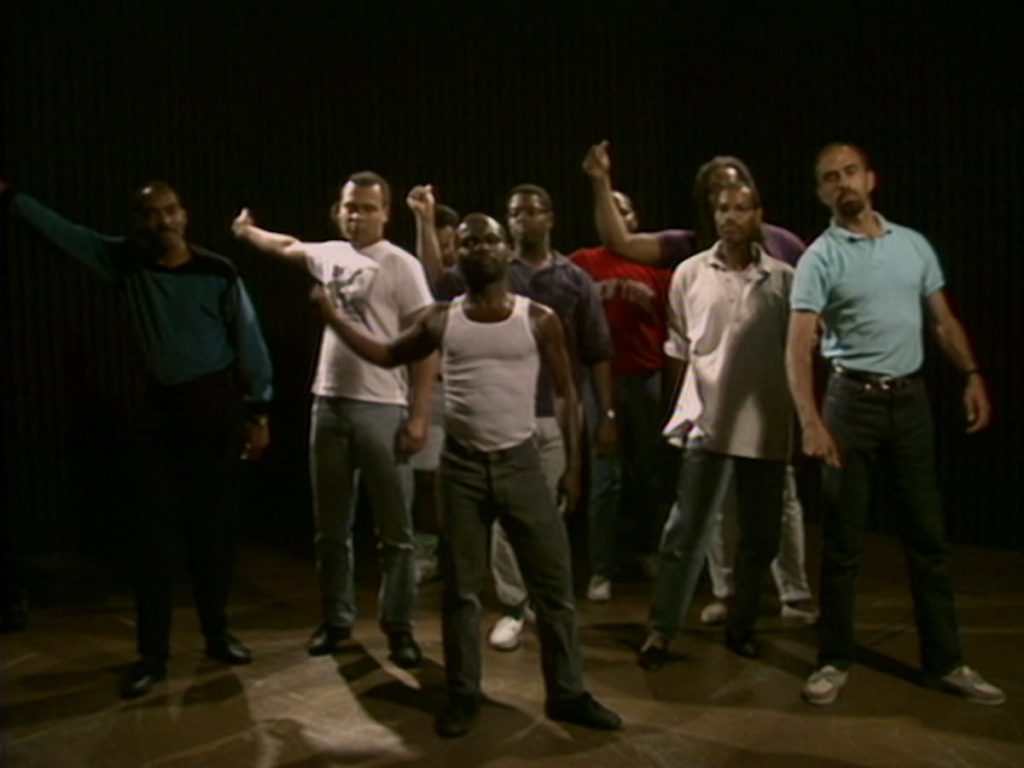There has never been a filmmaker like Marlon Riggs: an unapologetic gay Black man who defied a culture of silence and shame to speak his truth with resounding joy and conviction. An early adopter of video technology, Riggs employed a bold mix of documentary, performance, poetry, and music in order to confront the devastating legacy of racist stereotypes, the impact of AIDS on his community, and the very definition of what it means to be Black. Bringing together Riggs’s complete films—including his controversy-inciting queer landmark Tongues Untied and Black Is . . . Black Ain’t, the deeply personal swan song that was completed after his death at the age of thirty-seven—The Signifyin’ Works of Marlon Riggs traces the artistic and political evolution of a transformative filmmaker whose work is both an electrifying call for liberation and an invaluable historical document.

Ethnic Notions (1986)
In his first major work, a brilliant and disturbing deconstruction of the ways in which anti-Black stereotypes have permeated nearly every aspect of popular culture, Marlon Riggs brings viewers face-to-face with the insidious images that have shaped America’s racial mythologies. Through razor-sharp historical analysis and powerfully deployed imagery, Ethnic Notions illuminates, with devastating clarity, how dehumanizing caricatures of Black people—seen everywhere from children’s books to films to household products—have been used to uphold white supremacy and to justify slavery, segregation, and the continuing oppression of African Americans. In its refusal to look away, this Emmy-winning documentary, narrated by actor Esther Rolle, has become an essential text for understanding the origins of American racism.
The first of Riggs’ work is one of his more conventionally constructed pieces that follows the evolution of black imagery in popular culture chronologically and how it has only fostered racist notions even further. From the opening moment, you are introduced to the horrible archetypes that have hurt so many: “The Mammy, The Pickaninny, The Coon, The Sambo, The Uncle.” By exploring each of these figures more in depth, you further understand the power they have had over the lives of black people. The Sambo caricature is known to be carefree and “childlike” by most, but not everyone may understand the origins behind some of the exaggerated dancing movements that are rooted in Jim Crow laws. While it is wild to say that blackface has resurfaced as a common topic in recent years, the piece delves into various facets of the origins and the complicated history black performers have had with it throughout the years. At this end of this exploration, there is discussion about how much of this imagery was still with us, and from a modern perspective it is notable to see how slow change has come to completely eliminating this. While this does not delve into as much queer content as his other work, this piece is unflinching in its approach to shining a light on the ills of society.

Tongues Untied (1989)
Made, in director Marlon Riggs’s own words, to “shatter the nation’s brutalizing silence on matters of sexual and racial difference,” this radical blend of documentary and performance defies the stigmas surrounding Black gay sexuality in the belief that, as long as shame prevails, liberation cannot be possible. Through music and dance, words and poetry by such pathbreaking writers as Essex Hemphill and Joseph Beam—and by turns candid, humorous, and heartbreaking interviews with queer African American men—Tongues Untied gives voice to what it means to live as an outsider in both a Black community rife with homophobia and a largely white gay subculture poisoned by racism. A lightning rod in the culture wars of the 1980s that incited a right-wing furor over public funding for the arts, the film has lost none of its life-affirming resonance.
The opening moments of Tongues Untied clue you into the artistic shift that Riggs has made in the years since his first work. This piece is not just going to be shining a light on an important topic, but he is going to do it in only a way that he can. The lyrical chant of “brother to brother” is haunting in its simplicity, and if you are like me it will stick in your brain for long after you have stepped away from the film. It is said that this film was not made to “explain” same-sex love between black men to an outside community, but rather to tell their story and experiences in a way that would feel authentic to those in the community. In under an hour Riggs explores questions of what manhood means in the black community, black-on-black homophobia, the allure of white gay culture to black men (and the whole other set of issues this brings up), the painful experience of AIDS in the community and so much more. If this sounds intense, it certainly can be, but it can also be hilariously funny. The demonstration of “snap culture” is one of the best moments in this set. Many of these stories and experiences walk a fine line between humor and pain, which allows it to be as nuanced and complex as its subjects.

Affirmations (1990)
Marlon Riggs expresses the hopes, dreams, and desires of gay Black men in this ode to queer African American empowerment. Built around outtakes of interview and protest footage from Tongues Untied, Affirmations begins as a candid, sex-positive confessional about first-time penetration and evolves into a rousing chorus of calls for freedom, recognition, and inclusion.
At just over ten minutes in length, Affirmations may seem like one of the more minor works in this set, but that does not make it any less impactful. Reginald T. Jackson paints a picture that is unabashedly joyous in its celebration of queer love that will not be for everyone, but will mean a lot to those who do connect with what he is revealing on a deeper level. During an anti-homophobia march late in the piece, Riggs documents a dissenting voice condemning the marchers as “slaves” because of their orientation which sets the stage for a parallel exploration of the civil rights marches of yore.

Anthem (1991)
“Pervert the language.” Made at a time when Marlon Riggs was three years into living with HIV and the motto “Silence=Death” was the queer community’s defiant response to the antigay policies of the Reagan era, this experimental music video employs a mix of poetry, African beats, and provocative imagery—sexual, political, and religious—in order to challenge and redefine prevailing images of Black masculinity. Led by the liberated dancing of the filmmaker himself, Anthem is a bold vision of queer revolution, proclaiming “Every time we kiss we confirm the new world coming.”
Much like Affirmations, Anthem is a quick unadulterated dose of the queer revolution which takes a powerful stance against the antigay rhetoric and AIDS panic of the era. Those who watch all of these works close together will notice the striking Essex Hemphill as one of the most exhilarating contributors. His poetry performance of “American Wedding” will hit you like a ton of bricks.

Color Adjustment (1992)
What does the American dream look like? Where do Black Americans fit into it? And what is television’s role in shaping our views of racial progress and the idealized American family? Picking up where the groundbreaking Ethnic Notions left off, this pioneering work of media studies by Marlon Riggs presents a complicated, challenging, and nuanced view of evolving racial attitudes as reflected in popular programs such as Amos ’n’ Andy, Julia, All in the Family, Good Times, Roots, and The Cosby Show. Narrated by Ruby Dee and featuring interviews with actors Diahann Carroll, Tim Reid, and Esther Rolle; African American historian Henry Louis Gates Jr.; and producer Norman Lear, among others, Color Adjustment looks beyond the whitewashed, middle-class mythologies peddled by prime-time entertainment to track the ways in which Black Americans have been assimilated into a new but no less harmful racial narrative.
Riggs builds on what he accomplished with Ethnic Notions by honing in on the depictions of African Americans on television in a way that is fiercely potent. I have seen countless television specials over the years that have tackled similar subject matter, but rarely did they have the point of view that Riggs brings with this one. Early series like Amos ‘n’ Andy and Beulah were very obviously harmful in their depictions, but are shows like The Cosby Show or Julia really safe from criticism when it comes to representation? That Riggs gets to interview many of these important figures is a great coup for this piece which dares to challenge you to question what you have seen on television over the years and what it truly means. The way in which shows were robbed of the creative bite they could have had through tried-and-true stealth-racist techniques is maddening.

Non, Je Ne Regrette Rien (No Regret) (1993)
Through music, poetry, and courageous self-disclosure, five HIV-positive gay Black men (among them poet and performance artist Assotto Saint) discuss their individual confrontations with AIDS, illuminating their journeys through the fear, shame, and stigma that accompanied the disease at the height of the epidemic toward healing, acceptance, and truth. In Non, Je Ne Regrette Rien (No Regret), director Marlon Riggs tells stories of self-transformation in which a once unmentionable “affliction” is forged into a tool of personal and communal empowerment.
Viewing this particular piece can be a very visceral experience, and Riggs uses his artistic eye to make the point land even more forcefully. By obscuring the subjects while they tell their stories before ultimately revealing more of their figures as they bare their souls is really clever. These men have unique stories, but also the same in most key respects. These individuals are empowered in a way that will leave you with a sense of awe.

Black Is…Black Ain’t (1995)
Made with an urgency imparted by the knowledge that he was nearing the end of his life, Marlon Riggs’s final film—completed by a group of his devoted collaborators after his death of AIDS-related illnesses—is a wide-ranging consideration of a question that had long been central to his work: What does it mean to be Black? Using his grandmother’s gumbo recipe as a metaphor for the diversity of the African American experience, Riggs travels the country, seeking insights from leading thinkers like Angela Davis, Henry Louis Gates Jr., bell hooks, Barbara Smith, and Cornel West, as well as everyday people—young and old, rich and poor, rural and urban, gay and straight—all grappling with the numerous, often contested definitions of Blackness that have shaped their lives. Punctuated by footage of a dying Riggs directing his crew and delivering parting wisdom from his hospital bed, Black Is . . . Black Ain’t breaks down the divides of class, colorism, patriarchy, and homophobia as it issues a stirring appeal for unity.
This final work is given a greater sense of poignancy knowing that Marlon died before being able to complete his vision, leaving his closest friends to help the project across the finish line. When you view all of his work in close proximity, it is easy to point to this as the perfect culmination of everything Marlon was trying to capture in his work up until this point. All of the different facets of race and sexuality are covered. What does it mean to be “too black” or “not black enough,” and why is “black” considered a derogatory word to so many in the community? What is the role of women, and in particular gay women, in the larger cultural revolution? These are only a few of the topics explored along with discussions of straight versus natural hair and gang violence. It is a sprawling text that really goes to some places that you might not necessarily expect in a way that is quite exciting. It is hard to say goodbye to Marlon Riggs, but if you have to I cannot think of a better sendoff for him than a landmark cultural achievement.

Video Quality
The Blu-Ray set of The Signifyin’ Works Of Marlon Riggs features all seven films presented in their original 1.33:1 and is sourced from digital elements upconverted from a remaster completed in 2006 and 2007 from the original edited elements. Since these works were all shot on video, the presentation might not be as pinpoint precise as some from the label, but it features this work in the most beautiful manner possible. This is a very nice looking transfer that eliminates nearly all of the jitter and flicker that video tape often provides. When you consider the enterprising way in which these works were shot, it is impressive how great everything looks. There does not appear to be any issues with compression artifacts or any other such digital anomalies. The track does show off some detail in the clothing of the subjects and in the facial features. Colors present as vivid as the original format will allow. This presentation showcases these works in the most impressive manner that could possibly be expected.
Audio Quality
The new Blu-Ray set is presented with an LPCM 2.0 track for all the films in the set except for Affirmation and Anthem, which are given LPCM 1.0 tracks, all of which suit the material perfectly well. The words of the subjects are the standout aspect of these works, and they mostly come through quite well in relation to the competing sounds. Some of the more lyrical and poetic moments are imbued with a pleasing warmth within the track that is quite striking. There are minor sound issues due to the source material, but the most important thing is that the track remains faithful to the intention of the creative team. English subtitles are provided for those who desire them. These works sound as good as they possibly can in this Blu-Ray collection.

Special Features
The Criterion Blu-Ray of The Signifyin’ Works Of Marlon Riggs includes a booklet featuring the expansive essay “Positive Images” by film critic K. Austin Collins in which he discusses the themes and cultural significance of these works, the career of Marlon Riggs and much more. This provides a great amount of context and insight into this man that is so worthwhile. The on-disc special features are as follows:
- Introduction: A 23-minute introduction to the set with filmmakers Vivian Kleiman and Shikeith, and Ashley Clark, curatorial director of the Criterion Collection. This trio has a very interesting and worthwhile discussion from both the personal as well as the artistic perspective. There are clips utilized throughout this that would not really ruin the enjoyment of any of the work if you watched it first. This interview was recorded remotely in 2020.
- Marlon Riggs on POV: A nearly two-minute introduction to Tongues Untied is provided that was broadcast in 1991 in which Riggs briefly touches on why he decided to make the film. A minute-long introduction is also provided for Color Adjustment in which discusses his own experiences with race on television during his life.
- Long Train Running – The Story of The Oakland Blues: The 29-minute thesis film completed in 1981 which traces the evolution of the Oakland blues. Through a mixture of performances and interviews, Riggs tackles many themes that would be further explored in his later work.
- In The Life – Marlon Riggs: An 11-minute interview conducted in May 1992 for television’s longest-running LGBTQ newsmagazine program. Riggs discusses how his identity impacts his work and what he is trying to accomplish with his “transgressive” work. He makes a solid argument for what representation in media means for these minority communities.
- A Kindred Spirit: A nearly 22-minute piece in which collaborators Brian Freeman, Reginald T. Jackson, and Bill T. Jones discuss their relationship with Marlon, what it meant to them being a part of his community or artists, losses that were experienced, sharing themselves on film and more. There is also a reflection on what being a part of these works have meant to their lives. This is one of my favorite supplements on the disc.
- Editing With Marlon: A 16-minute interview with filmmaker and editor Christiane Badgley in which she discusses getting connected with Marlon, the freedom that he gave to her, the grace that was shown in the editing room, the place of poetry in his work and much more.
- The Everlasting Influence of Marlon Riggs: A 21-minute conversation with filmmakers Cheryl Dunye and Rodney Evans and poet Jericho Brown in which they discuss the impact of Marlon Riggs on their own lives and art and what it has meant to them over the years. It is lovely getting to further explore how his legacy continues to live on through the art of future generations.
- Ethnic Notions and Color Adjustment – A Twenty-First-Century Conversation: A 21-minute conversation between film and media scholar Racquel Gates and sociologist Herman Gray in which they reflect upon Riggs’ powerful critiques of the racial stereotypes and oppressive constructs presented in film and television. There are comparisons between the two works including the ability to interview the subjects as opposed to simply presenting the material and letting it speak for itself. There are also important discussions about the enduring legacy of these works and what the impact it has had on the modern cultural landscape.
- I Shall Not Be Removed – The Life Of Marlon Riggs: A 59-minute film from Karen Everett produced in 1996 that serves as a biography piece for the late artist. This film features numerous insightful interviews with Riggs, his friends and collaborators and members of his family. It is worthwhile to get a portrait of Riggs that is not framed through his own lens, including a look at his life with his long-time partner. If you were viewing this film in a vacuum, it would most certainly inspire you to seek out his work if you had not seen it yet.
Final Thoughts
The Signifyin’ Works Of Marlon Riggs is a collection of films from a powerful creative figure taken from this world way too soon. While the material may seem intimidating to some due to the hard-hitting social issues that he is covering, Riggs never fails to find a way to make his topics less than enthralling. While the most recent of these is still over 25 years old, the material remains as relevant and powerful as ever. The Criterion Collection has released a two-disc set that sports a solid A/V presentation and a host of special features that greatly enhance the experience. This is the type of work that the Criterion Collection was made to lift up for the grand achievement that it is. Recommended
The Criterion Collection edition of The Signifyin’ Works Of Marlon Riggs is currently available to purchase on Blu-Ray and DVD.
Note: Images presented in this review are not reflective of the image quality of the Blu-Ray.
Disclaimer: The Criterion Collection has supplied a copy of this disc free of charge for review purposes. All opinions in this review are the honest reactions of the author.

Dillon is most comfortable sitting around in a theatre all day watching both big budget and independent movies.







